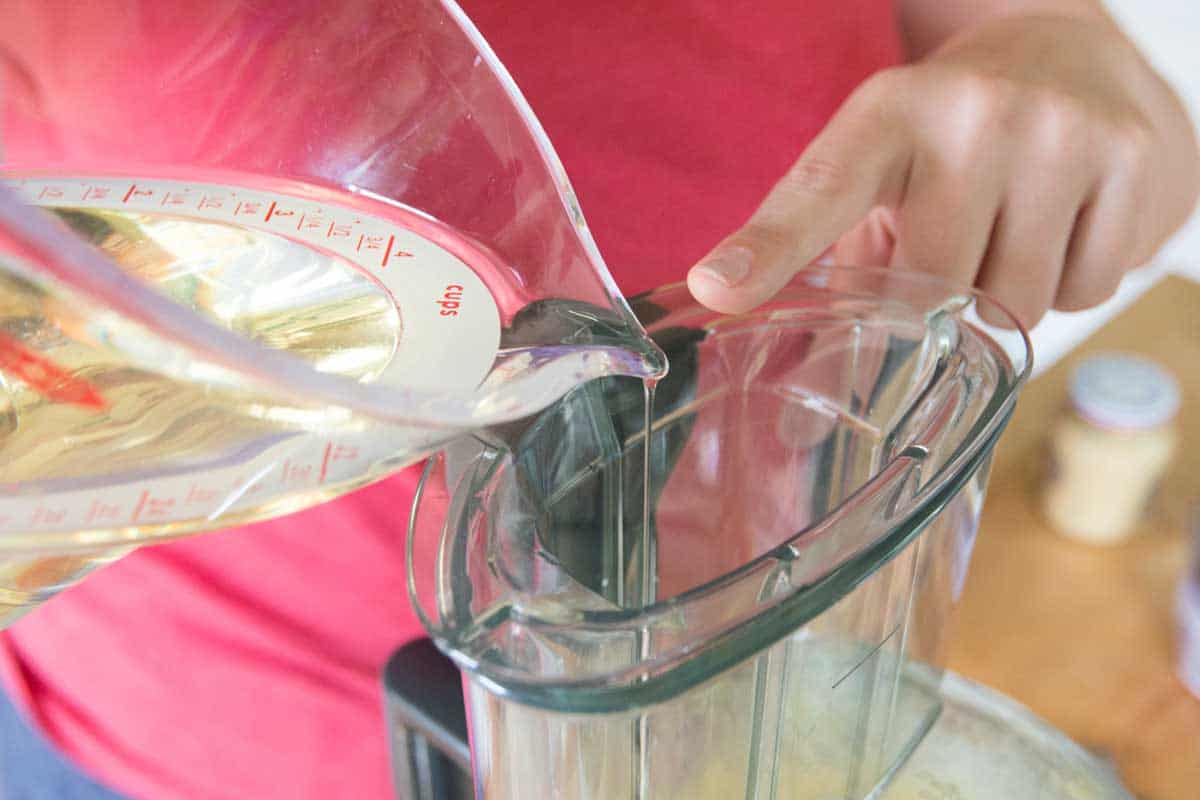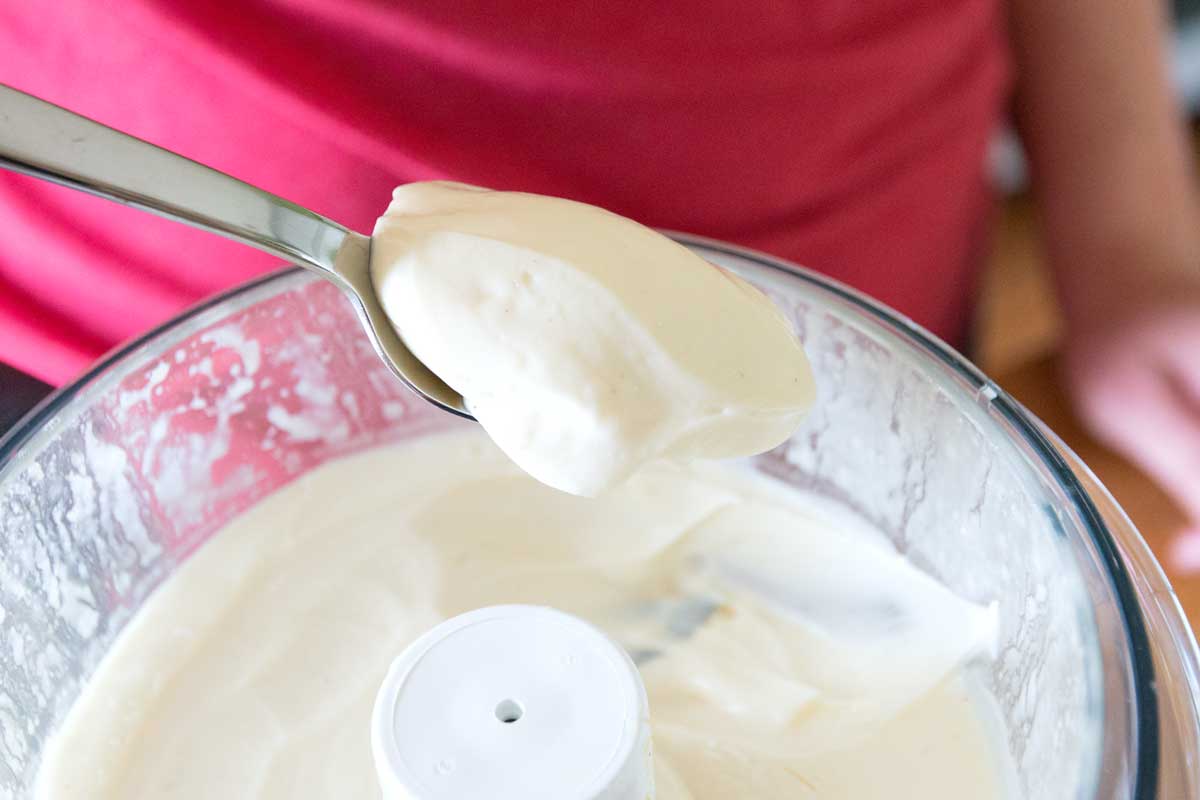How to make mayonnaise in less than 10 minutes! Using whole eggs instead of just the yolk, makes this homemade mayonnaise recipe practically fail-proof and extra easy.
I’ve used this mayonnaise recipe more times than I can count. If you’ve never tried homemade mayonnaise, then you are in for a treat. Homemade mayo is ultra creamy and so much more flavorful than anything you can buy at the store. Here’s why I love this recipe so much:
Homemade mayo lasts about two weeks in the fridge, but in all honesty, once I have a batch in my fridge, it usually goes quicker than that. I love using it to make sandwiches like egg salad or chicken salad, and I find it makes creamy salads like potato salad and shrimp salad extra special.
The ingredients to make mayo are simple — we bet you even have them in your kitchen right now. You will need the following:
⭐️ Room temperature ingredients are best when making mayonnaise. If you’re not able to wait for the egg to come to room temperature, submerge it in lukewarm (not hot) water for a couple of minutes.
Homemade mayonnaise is more flavorful than the storebought stuff, since it’s made with fresher ingredients, like egg yolk and just-squeezed lemon juice. Also, there are no preservatives or stabilizers in homemade mayo, so the texture is creamy and velvety, not squelchy and gelatinous.
/how-to-make-mayonnaise-996044_v2-34db07c1668b47eca8b6827c8d957945.png)
How to Make Mayonnaise, You’ve Got This!
There are a few ways to make mayonnaise. For the best results, we use our food processor with the small bowl attachment, but an immersion blender or making it completely by hand will work. (Expect tired arms and strong biceps if you do choose to do it by hand.)
- Prepare your food processor. I prefer to use the small bowl attachment that came with our food processor to make mayonnaise.
- Add an egg to the bowl of your food processor and process for about 20 seconds.
- Add mustard, vinegar, and salt then process for another 20 seconds.
- Slowly add the oil, in tiny drops, until about a quarter of the oil has been added. Adding the oil slowly is really important. If you were to dump it all in at once, you’d have mayonnaise soup!
- Taste the mayonnaise and adjust with additional salt and vinegar or lemon juice.


For the best mayonnaise, add the oil slowly very slowly. When the mayonnaise is done, it will be thick and creamy (as shown in the photos).
I love this classic mayonnaise as-is, but love it even more when I make it my own. I almost always add a squeeze of lemon juice to brighten things up a little. I love how fresh it makes it taste.
Fresh herbs, roasted garlic, chipotle, Sriracha or curry powder are all amazing options, as well. You might also enjoy our garlic aioli recipe, which is very similar to this recipe, but uses egg yolks instead of whole eggs.
How to Fix Broken Mayonnaise
When making mayonnaise, the worst, but not unfixable, thing that can happen to you is that the mixture breaks, leaving you with a curdled mess.
The recipe we’ve shared tries to prevent this a few ways: we use a whole egg, which adds a little more liquid to the mix, mustard acts as an emulsifier from the get-go and we are careful to stream our oil in slowly.
While we have never had this particular recipe for mayonnaise break on us, if it happens to you don’t fret! You really should be able to fix it. Here are two suggestions for fixing broken or thin mayonnaise:
- Add an egg yolk to a large bowl and slowly use a whisk to beat the broken mayo, bit by bit, into the yolk. My preferred method!
- Add about 1 teaspoon of mustard to a bowl then use a whisk to slowly beat the broken mayonnaise, bit by bit, into the mustard until it becomes emulsified and creamy again.
Do I have to use raw eggs to make mayonnaise? Eggs are essential for making mayonnaise. Risks of using raw eggs are low, but there is a chance that the egg contains a germ called Salmonella. Personally, I am not too concerned about this, but here’s what the CDC suggests you do to reduce the risks of using eggs:
- Consider buying and using pasteurized eggs
- Keep eggs refrigerated at 40°F (4°C) or colder at all times.
- Only buy eggs from stores and suppliers that keep them refrigerated.
- Discard cracked or dirty eggs.
Do I need to use mustard? You can make homemade mayonnaise without mustard, but remember that mustard is one of the fail-safes we have added to our recipe to encourage an emulsification.
Can I use olive oil to make mayo? Yes, but keep in mind that quite a bit of oil is called for in the recipe so a strong or robust flavored oil will make the mayonnaise strong in flavor. When I use olive oil, I like using a light, fruity brand and only replace half of the oil with olive oil and use a neutral flavored oil for the remaining oil.
My mayonnaise won’t thicken, what am I doing wrong? Ugh, I’m sorry! Broken mayonnaise happens to everyone and it doesn’t necessarily mean that you did something wrong or that the recipe you used was a bad one. The key thing to keep in mind when making mayo is to add that oil slowly, and by slowly, I honestly mean to add it drop by drop. Take a look above in the article where I outline a couple of fixes to broken mayo.
How long does homemade mayonnaise last? Here’s the thing, homemade mayo will last as long as your eggs would have lasted. A good rule of thumb is that mayo will keep covered in the fridge up two weeks, but you might find that it lasts a little longer depending on the freshness of your eggs.
BEFORE You Make MAYO, THIS is the #1 Ingredient to keep it for 3 Months Fresh in the Fridge!
FAQ
Is it cheaper to make your own mayo or buy it?
Why is homemade mayo not advisable?
Does homemade mayonnaise taste better than store bought?
Is homemade mayo better than Hellmans?
Does mayonnaise make a difference?
Many people think of mayonnaise as a condiment, but it’s also an essential ingredient for so many favorite recipes like chicken salad, the best egg salad, deviled eggs, or homemade blue cheese dip. The deliciousness of the mayo you’re using can totally make or break those kinds of recipes.
How do you make homemade mayonnaise?
With only four ingredients that you probably already have around the house and five minutes of your time, you can make homemade mayonnaise. Mayonnaise is simply an emulsion of oil and egg yolks, with a little acidity and salt added to brighten the flavors. Here’s the basic recipe: Separate the egg whites from the yolks.
Is homemade Mayo better than store-bought?
With homemade, we know that the eggs are top-quality, we can choose the type of oil being used, and we know it’s fresh. Homemade mayo wins in taste, as well. The real stuff is creamy and rich, with a natural tanginess. By comparison, store-bought often tastes like a watery imitation.
How do you make mayonnaise taste good?
Use a neutral-flavored oil. My favorite is avocado oil. Avoid olive oil or your mayonnaise will have a very strong flavor. Use salt, but sparingly. A pinch or two is all you need. Always use freshly squeezed lemon juice. The stuff you buy in bottles will make your mayonnaise taste funny.
